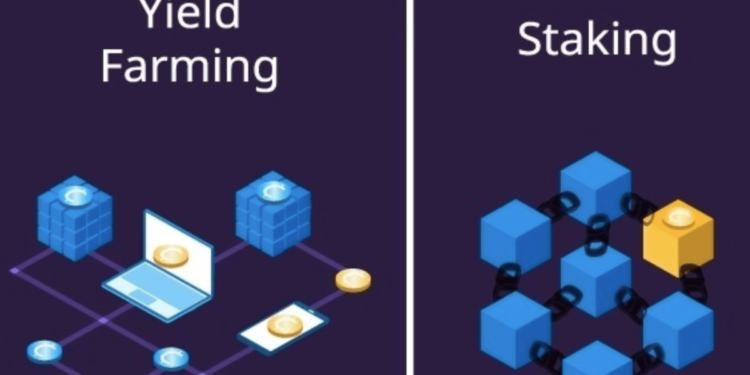Even though both yield farming and staking both serve as inventive approaches for generating passive earnings, they still have differences in numerous aspects. lets delve into this interesting topic now.
1. Levels of Complexity
Yield farming and staking contrast in their accessibility and connected learning curves. Yield farming is typically more intricate as it demands thorough investigation to pinpoint potentially lucrative liquidity pools. Providers of liquidity must recognize a liquidity pool that presents favorable interest rates for supplying liquidity. Subsequently, they need to make choices regarding a token pair and opt for a DeFi platform that provides either a customizable liquidity pool or an equilibrium liquidity pool.
Staking is frequently more straightforward to comprehend, as users merely have to pick a staking pool in a Proof of Stake network to stake cryptocurrency. Since staking commonly involves a stipulated lock-up period during which stakers are prohibited from withdrawing their deposit for a designated duration, the procedure is predominantly passive after users stake their crypto assets.
In contrast to yield farming, which demands active management to yield returns, staking mandates minimal exertion from users once assets are staked.
2. Deposit Period
Versatility is a significant aspect in any decision-making process between yield farming and staking.
Yield farmers are not obligated to secure their cryptocurrency in a liquidity pool for a predetermined duration to acquire rewards from yield farming protocols. They have the freedom to provide liquidity to any pool and retrieve their tokens at their convenience.
In the absence of a minimum lock-up pool, yield farmers can even transfer their funds from one pool to another. On the other hand, staking might encompass fixed lock-up periods during which users are unable to withdraw their stake. These durations can range from a few days to several weeks (or potentially months), contingent on network traffic. The smart contracts of staking protocols systematically guarantee users cannot withdraw funds before the unbonding period concludes. Irrespective of market conditions, one cannot unstake crypto until the unbonding period terminates.
3. Transaction Costs
When deliberating between yield farming and staking, transaction costs (gas fees) should also be taken into account. When yield farmers transition between liquidity pools, they must cover transaction costs to execute those transfers. Users on the Ethereum network might encounter high gas fees for a straightforward on-chain transaction. Yield Farmers must contemplate the potential of incurring elevated gas fees when deciding whether to relocate assets between liquidity pools.
Given that staking necessitates the immobilization of user assets with no opportunity to switch pools, stakers are exempt from paying gas fees. Instead, they acquire a percentage of network fees when validating transactions. Compared to liquidity pools, staking involves substantially lower maintenance expenses.
4. Requirements
Yield farming and staking differ in the quantity of tokens users require for their investments.
Yield farming mandates a pair of tokens, such as USDT-USDC or ETH-DAI, for supplying liquidity to liquidity pools. Users can contribute a flexible ratio of these tokens to the trading pair for customizable pools. However, they must provide tokens in a 50-50 ratio to equilibrium pools with trading pairs holding equal value.
Staking revolves around only one token that users can lock up in the staking pool. Consequently, stakers do not need to purchase two tokens of equal or variable value to provide liquidity. This could potentially diminish the overall expenditure of participating in staking for certain tokens. Nonetheless, specific tokens necessitate a staker to commit a minimum quantity of tokens to stake; for instance, each validator node must stake a minimum of 32 ETH.
5. Revenue Generation
Revenue creation is yet another distinguishing element between yield farming and staking.
Yield farming presents a dynamic Annual Percentage Yield (APY) that fluctuates with each liquidity pool, contingent on numerous market metrics: available liquidity, arbitrage options, and overall volatility.
In contrast, staking offers a fixed APY, allowing users to calculate future returns and strategize accordingly. Although the interest rate is often lower than yield farming, a stable percentage frequently aligns well with low-risk investors. Moreover, those locking up their tokens for extended durations earn higher APYs compared to short-term lock-up periods.
6. Investment Risks
Users must also be cognizant of the security infrastructure and associated risks when comparing yield farming versus staking. Yield farming protocols are susceptible to a variety of risks that could result in the loss of user funds. Losses might arise due to token price fluctuations, including impermanent loss, when the price of one token changes relative to the other during the period that the coins are locked in a liquidity pool.
Bugs or errors in smart contracts could lead to smart contract risk, rendering the protocol vulnerable to hacking. Rug pulls are another prevalent risk for new yield farming projects with dubious, anonymous developers leading the way. Staking is comparatively more secure since stakers must adhere to stringent guidelines to partake in a blockchain’s consensus mechanism. In a Proof of Stake blockchain, malicious users can forfeit their staked assets through slashing if they attempt to manipulate the network for increased rewards. Further elaboration on this will follow.












